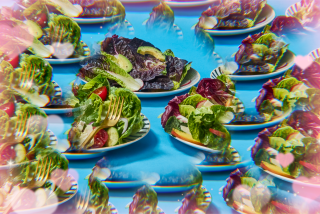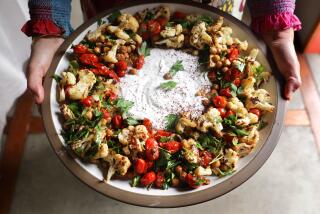Move Over, Yan; Kids Can Cook
- Share via
A couple of months ago I was asked to teach a children’s cooking class. This was nothing new--I’ve been teaching children the basics of cooking for more than two years. But the room to which I was assigned had no running water, stove or cooking equipment. And, at the last minute, I discovered I had a gaggle of 3-year-olds to teach; the children I had worked with before were 7 and older.
It took a little improvising, but I devised the following recipe, Salad on a Leaf, which taught the children a little about handling lettuces--and lots about how to make a salad dressing.
I arranged small plastic bowls and teaspoons all around, then poured olive oil, vinegar, water and salt into four plastic bowls that I put in the middle of a work table.
The lettuces had been washed and dried, and each child had several leaves. I told them to tear the lettuce into smaller pieces. They were great at tearing up the lettuce. Next, I explained that they were to use their teaspoon to measure and put a teaspoon each of vinegar and water into their bowl, then add a tiny pinch of salt to their little bowls.
This was the point at which communication broke down. They didn’t understand measuring; when they got a few drops of vinegar or water on their spoon they thought they had a whole spoonful. The pinch of salt, however, worked splendidly.
They were a little clumsy at stirring, but once I showed them how to hold the bowl with one hand and stir with the other, success was closer. Even so, it isn’t as simple to stir as one would think. They were to stir until they couldn’t feel the grains of salt at the bottom of the bowl. But one mustn’t try to make finished cooks out of beginners. Last, the olive oil was added and stirred.
Then the great moment of tasting their dressing arrived. I told them to dip a piece of lettuce into their salad dressing and taste. I asked them to tell me if they liked it.
You have never seen so many puckered up little faces--not a smile to be seen.
I asked, “What would you add to your salad dressing to make it taste better?
One little girl said, “sugar.” And one little boy, amazingly, said, “orange juice.” He just might turn out to be a great chef.
Surprisingly, most of the children kept dipping their lettuce pieces into their dressing while they watched each other doing the same thing.
I think they had fun, I know I did, and they may never be the same when they eat salads in the future. I learned lots more than I imparted. Three-year-olds really can cook.
SALAD ON A LEAF
Note that the salad dressing amounts are much more than needed, but it makes the child measure and think about what he or she is doing. Before beginning, the parent or supervising adult should put the 1/4 cup olive oil, 1/4 cup water, 2 tablespoons cider vinegar and 2 tablespoons salt in each of the 4 small glass bowls.
Equipment Needed
1 (2-cup) measuring cup
4 small (about 3/4-cup) glass bowls
1 teaspoon
1 small (about 4-cup capacity) salad bowl
Paper towels to dry the lettuce leaves and to hold the torn lettuce while making the salad dressing
Ingredients
4 butter lettuce
leaves
4 red lettuce leaves
2 iceberg lettuce leaves, slightly cup-shaped
1/4 cup olive oil
1/4 cup water
2 tablespoons cider vinegar
2 tablespoons salt
PREPARING THE LETTUCES
Rinse the butter lettuce, red leaf lettuce and iceberg lettuce leaves under cold running water. Shake the leaves to get rid of excess water and use paper towels to pat the leaves dry. Dry them well so that the salad dressing will stick to the leaves when you mix the salad. Put the two iceberg leaves aside.
Tear the butter lettuce and red leaf lettuce into bit-size pieces.
Measure the torn leaves in the 2-cup measuring cup. Don’t push them down too hard in the cup. Just lightly put the leaves in the cup, pushing down lightly. This measure doesn’t have to be exact. Put the 2 cups of lettuces on a paper towel and set aside. If you have leaves left over, place them in a plastic bag and put them in the refrigerator.
PREPARING THE DRESSING
Using your teaspoon, measure and put 2 teaspoons of vinegar in the salad bowl. Next add 1 teaspoon of water. Now add not quite 1/2 teaspoon, or a pinch, of salt (you can always add more salt when you taste your dressing). Stir the vinegar, water, and salt with your teaspoon. Leave the mixture alone for about 2 or 3 minutes, so the salt will melt into the vinegar and water. Stir again.
Now add 6 teaspoons of olive oil to the vinegar, water and salt mixture. Stir round and round so everything gets blended together.
Now for the interesting step, take a piece of lettuce that your tore up and dunk it into the salad dressing. Taste it. Is it to sour, is it too salty, is it too oily? Close your eyes and think about it, take another piece of lettuce dipped into the dressing and taste again. If you dressing is too sour, add 1 more teaspoon of water and 2 more teaspoons of olive oil. If it needs salt, add a pinch at a time, stir it into the dressing and taste the dressing on another piece of lettuce. When you like it, it is right.
PUTTING IT TOGETHER
Put your 2 cups of torn lettuce leaves into the salad bowl. Using your hands, lightly toss and turn the lettuces form the bottom of the bowl to the top. Do this over and over gently until all the leaves look shiny. When the leaves look shiny it means they have all been covered with salad dressing, which is just what you want.
Divide the salad in half and pile half on each of the iceberg lettuce leaves. The iceberg lettuce leaves act like a handy little plate for your salad and you can eat your plate too in this case.
More to Read
Eat your way across L.A.
Get our weekly Tasting Notes newsletter for reviews, news and more.
You may occasionally receive promotional content from the Los Angeles Times.










